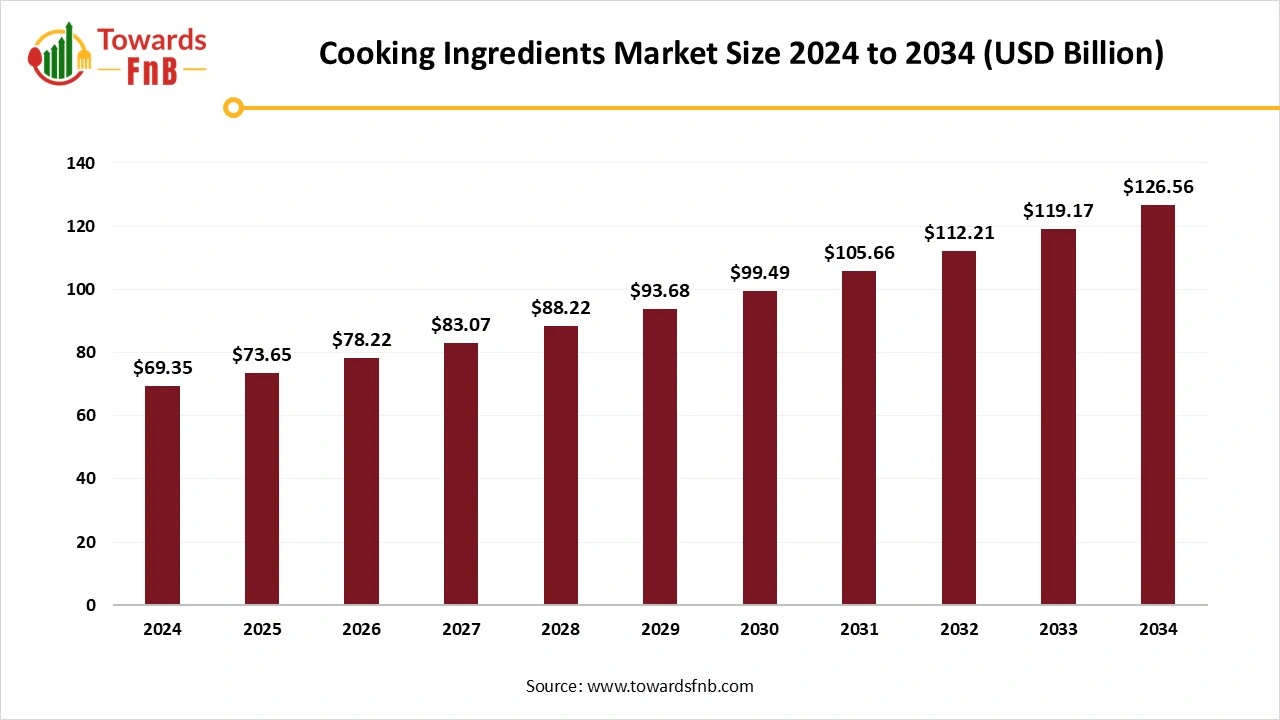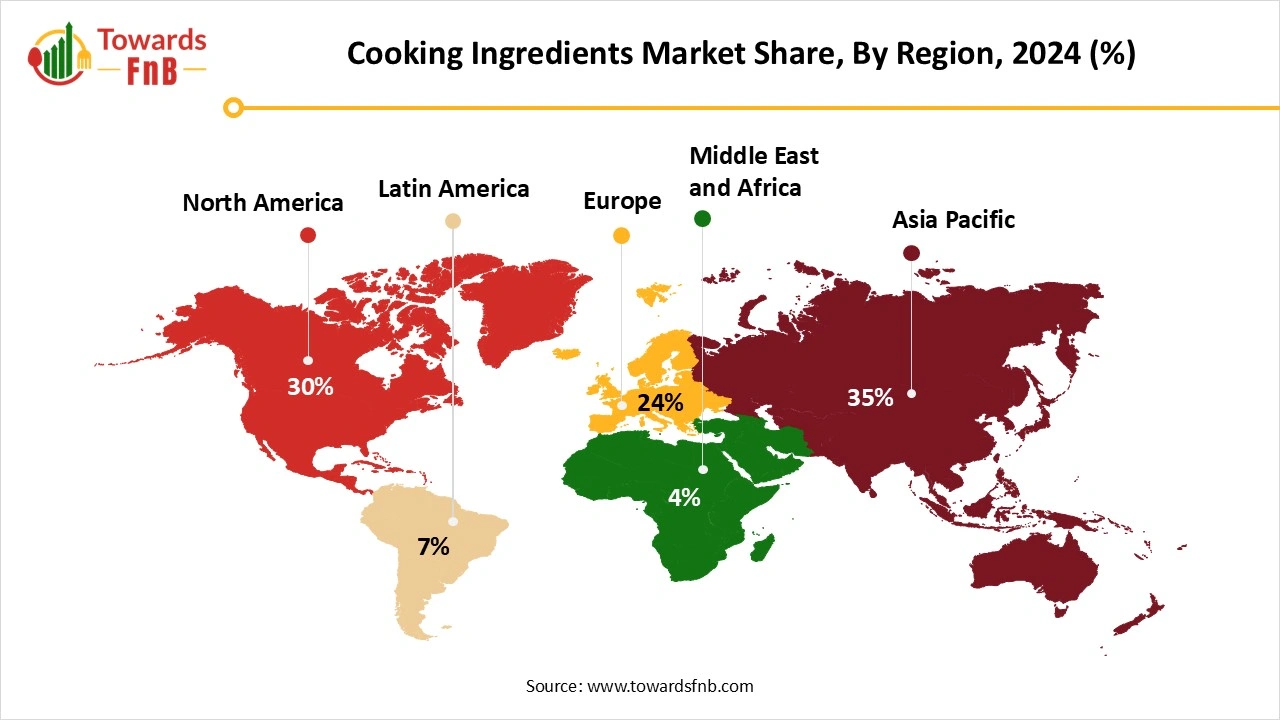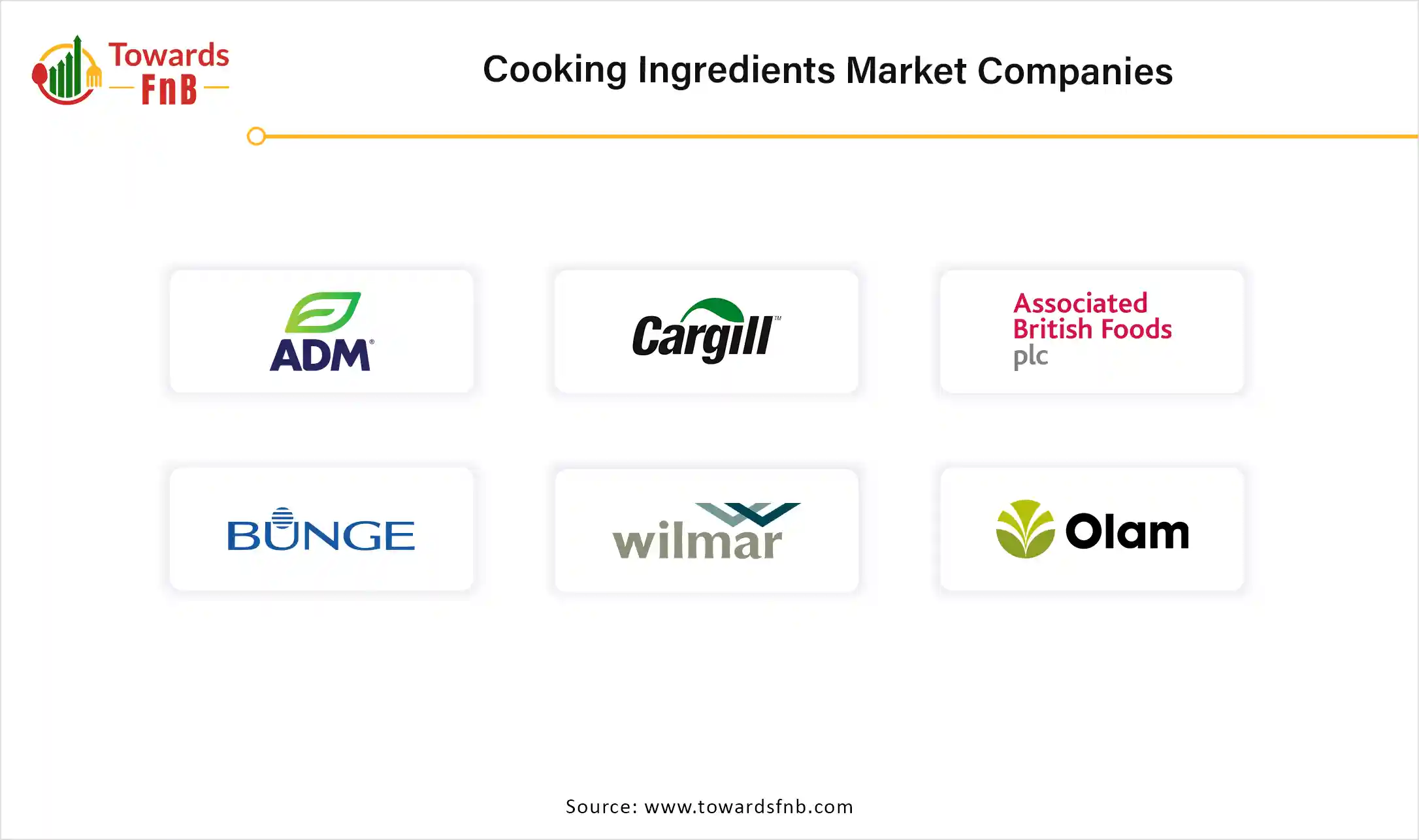November 2025
The global cooking ingredients market size was valued at USD 69.35 billion in 2024 and is expected to grow steadily from USD 73.65 billion in 2025 to reach nearly USD 126.56 billion by 2034, with a CAGR of 6.2% during the forecast period from 2025 to 2034. Growth of the market is driven by various factors such as changing consumer preference, consumer demand for the processed and convenience food and rising demand for the functional ingredients.

| Study Coverage | Details |
| Growth Rate from 2025 to 2034 | CAGR of 6.2% |
| Market Size in 2025 | USD 73.65 Billion |
| Market Size in 2026 | USD 78.22 Billion |
| Market Size by 2034 | USD 126.56 Billion |
| Largest Market | Asia Pacific |
| Base Year | 2024 |
| Forecast Period | 2025 to 2034 |
| Regions Covered | North America, Europe, Asia-Pacific, Latin America, and Middle East & Africa |
The global cooking ingredients market refers to the commercial and consumer trade of essential substances used in preparing food, enhancing flavor, texture, nutrition, or preservation. This market includes edible oils, sweeteners, condiments, spices, herbs, flours, sauces, and other ingredients used in both household and industrial cooking processes. Demand is driven by evolving culinary habits, health trends, processed food consumption, and regional dietary preferences.
The emergence of personalized nutrition, which customizes diets based on individual health requirements and preferences, opens a new realm in the cooking ingredient sector. Components formulated for particular health advantages like enhanced digestion, increased energy, or immune defense will gain more popularity as buyers pursue tailored health remedies. This extends past conventional fortification, necessitating components that can be mixed in particular proportions or formats for specific advantages.
Cooking ingredient firms are creating customized food components by utilizing data analysis, AI, and cutting-edge technologies to adapt products to unique requirements and tastes. This includes developing unique premixes with targeted nutrients, utilizing precision fermentation for personalized options, and providing modular systems for users to craft their own mixtures.
The cooking ingredient industry encounters strict regulations designed to guarantee food safety and quality. Adhering to these standards, especially about additives, preservatives, and allergens, can pose difficulties for manufacturers. Regulatory demands differ by region, increasing complexity for businesses operating internationally. The expense of raw materials for food components, such as agricultural goods and natural resources, can fluctuate because of elements such as climate change, supply chain interruptions, and market needs.
Asia Pacific Held the Largest Share of the Cooking Ingredients Market in 2024.
The Asia Pacific area has a significant and expanding population, leading to a considerable need for food and drinks and, therefore, cooking ingredients. Hectic lifestyles and higher disposable incomes are fueling the demand for convenient and processed food items, ultimately enhancing the market for cooking ingredients. As reported by the Soft Copy, a bi-weekly publication created by multimedia students at the Indian Institute of Journalism and New Media, there was a 20% rise in sales of ready-to-eat food items in March 2023. Sales increased from 50% in 2022 to 70% in 2023. Consequently, the increasing demand for ready-to-eat products is expected to enhance the cooking ingredients sector in the years ahead. Consumers are increasingly recognizing the health advantages of functional foods and are proactively looking for items with particular nutritional characteristics. Food producers in the Asia Pacific area are continually creating food items that incorporate functional components like omega-3s and probiotics to satisfy the increasing consumer appetite for food products with diverse health advantages.

The market for cooking ingredients in India is expected to experience robust demand in the upcoming years. The rising need for convenience food and ready-to-eat meals significantly drives market expansion. Swift urban growth and increased population density have boosted trade operations in multiple industries. As food-borne illnesses rise, people are becoming more aware of their health and are seeking natural food components. This element will positively influence the increasing market demand throughout the forecast period. The food processing industry has become a significant part of the Indian economy regarding its contributions to gross domestic product, exports, investment, and job creation. Growing food processing sector further boosting the market of the cooking ingredients.
Middle East & Africa Cooking Ingredients Market Expects Significant Growth During the Forecast Period.
The market is growing consistently due to rising urbanization, demands from the middle class, and greater consumption of processed and convenience foods. Moreover, shoppers are more mindful of their health these days, leading to a rising demand for natural ingredients, organic products, and clean-label components, particularly plant-derived proteins, natural sugars, and beneficial additives. This trend is motivating food producers to redesign products with better and more clear ingredients. In line with the larger movement towards healthier dietary choices, there is an increasing need for food items that are low in sugar or sugar-free. Food producers are adding sugar substitutes like monk fruit, stevia, and erythritol to their products to satisfy consumer preferences for lower-sugar choices.
The Saudi Arabia is anticipated to experience significant growth in cooking ingredients primarily because of investments in the food and beverage sector, driven by evolving consumer habits. Saudi Arabia is becoming a more appealing place for investment, as the Kingdom’s economy is positioned 16th in the G20 and 18th worldwide, boasting a GDP of $1.01 trillion in 2022 based on IMF estimates. The increasing population of Saudi Arabia and rising disposable incomes are resulting in greater total food consumption and an eagerness to invest in premium and specialty food products. Saudi Arabia has the potential to become the center for the cooking ingredients industry, meeting the needs of neighboring countries. Expansion of internet-based digital platforms to facilitate food product purchasing. Moreover, the rising quantity of restaurants and hotels amplifies the demand for food products which further boosting the cooking ingredients market.
Why did Edible Oils Segment Dominated the Cooking Ingredients Market in 2024?
Edible oils segment led the cooking ingredients market in 2024. The expansion of the edible oil segment is fueled by increasing health awareness among consumers and a preference for plant-based oils such as sunflower, olive, and peanut oils in cooking. Due to the growing prevalence of obesity and heart-related problems, consumers are increasingly opting for healthier oil choices. Additionally, regular product releases that address consumer interest in new flavors and combinations, along with successful marketing strategies from major companies, are propelling market expansion.
Plant Based Sweeteners Segment is Observed to Grow at the Fastest Rate During the Forecast Period.
The growth of the plant-based sweetener segment is fueled by the increasing demand for low-or no-calorie natural ingredients utilized in food and drinks, along with the concern for maintaining a healthy lifestyle among people worldwide. Individuals are opting for familiar, naturally sourced foods in their diets instead of items with complex names or laboratory-created mixtures as preferable substitutes for sugar.
Which Source Segment Dominated the Cooking Ingredients Market in 2024?
Plant-based segment held the dominating share of the cooking ingredients market in 2024. The segment for plant-based food ingredients has witnessed significant expansion due to rising consumer interest in healthier and more sustainable food choices. Raising consumer awareness of meat substitute products is likely to boost demand for plant-based ingredients. Currently, most people are moving to a vegan diet, which will drive market growth in the coming years.
Fermented/Bio-Based Ingredients Segment is Seen to Grow at a Notable Rate During the Predicted Timeframe.
Raising consumer awareness regarding the health advantages of fermented products, including better digestion and boosted immune function, is a key factor. Moreover, the increasing demand for natural and organic food items, along with the rising trend of clean-label components, is driving market growth. Improvements in fermentation technology are boosting production efficiency and quality of products, resulting in fermented ingredients being more available and cost-effective.
Which Form of the Cooking Ingredients Dominated the Cooking Ingredients Market in 2024?
Liquid segment dominated the market with the largest share in 2024. Elements like distribution and user-friendliness in food and drink applications are driving the demand for this segment. Liquid components spread evenly, yielding a uniform product distribution that enhances flavor and texture.
Paste/gel Segment is Expected to Grow at the Fastest Rate in the Market During the Forecast Period.
Paste's stability contributes to consistent quality in dishes and cakes, earning the trust of numerous prominent restaurant chains and bakeries. Paste fulfills various roles as an appropriate component for diverse culinary creations. Drinks gain from Paste as it facilitates the creation of smoothie and cocktails, along with mocktails, fruit teas, and various other beverage types.
Which Application Held the Largest Share of the Cooking Ingredients Market in 2024?
Household segment held the largest share of the market in 2024. An important section of the cooking ingredients market, including diverse applications in routine cooking and food preparation at home. These components improve flavor, consistency, looks, and nutritional quality of meals, adding to a wide variety of culinary experiences. Active lifestyles result in a tendency for convenient ingredients that shorten cooking duration due to which demand for the cooking ingredients has boosted. Various cultures and culinary traditions have distinct ingredient choices, affecting the demand for particular products. Home cooking involves a diverse array of components utilized in baking, food preparation, and the making of different meals, with a significant increase in the desire for specialized ingredients to cater to particular dietary needs and tastes.
Industrial Food Processing Segment is Observed to Grow at the Fastest CAGR During the Forecast Period.
This can be linked to evolving consumer lifestyles and food choices that have spurred the expansion of the processed food production industry, which is expected to increase the need for specialty cooking ingredients. The worldwide awareness of nutrient-rich foods is rapidly increasing. This awareness is associated with increasing urbanization, escalating health-care expenses, and changing dietary patterns. The government's initiative to inform rural populations about nutrition, a rising proportion of working women, educated individuals, and the limited time available for cooking have all led to a higher demand.
Which Distribution Channel Dominated the Cooking Ingredients Market in 2024?
Offline retail segment led the cooking ingredients market in 2024. In the cooking ingredients market, offline retail channels mainly consist of hypermarkets, supermarkets, convenience stores, and traditional grocery shops. These channels provide a broad range of products and brands, addressing various customer preferences and buying behaviors. Numerous shoppers continue to favor purchasing cooking ingredients in physical stores, appreciating the chance to examine products, evaluate brands, and possibly negotiate prices. Physical stores provide instant access to products, which can be essential for everyday meal preparation.
Online Retail Segment is Seen to Grow at a Notable Rate During the Predicted Timeframe.
Online shopping avenues in the cooking ingredients sector consist of well-known e-commerce sites such as Amazon Fresh and BigBasket, along with dedicated grocery delivery services like Blinkit. These platforms utilize technology and logistics to provide a diverse selection of ingredients, frequently with convenient delivery choices. The creation of culinary content, such as videos, recipes, and blog entries, is becoming more significant in boosting online sales, as shoppers look for ideas and advice for their meal preparation.
Which Function Segment of Cooking Ingredients Market Held the Biggest Share in 2024?
Flavoring agent segment held the biggest share of the cooking ingredients market in 2023. The flavorings agent segment has witnessed notable expansion, propelled by rising consumption of processed food, innovative product creation, and an escalating preference for natural and nature-identical flavorings. Flavoring agents, which improve the taste and scent of food, are an essential part of the food industry, influencing both natural and processed food items. More than 45 nations participate in the worldwide export of Flavoring Agent, with China being the top exporter. Its 443 export shipments demonstrate its notable market share of 22%.
Nutritional Enhancer Segment is Expected to Grow at the Fastest CAGR in the Market During the Forecast Period.
Increased consumer awareness regarding health and wellness is boosting the demand for nutritional additives in food items. The rising occurrence of chronic illnesses like diabetes and obesity has resulted in a transition toward preventive healthcare strategies, enhancing the need for fortified foods and drinks that are enriched with vitamins, minerals, and omega-3 fatty acids. These enhancers are becoming more popular in food and drink items, as they address a variety of dietary requirements, such as weight control, increasing energy, and improving immune response.
International Food Products Corporation
Solina
Shiru

By Type
By Source
By Form
By Application
By Distribution Channel
By Function
By Region
The global cheese powder market size is projected to expand from USD 5.21 billion in 2025 to USD 9.33 billion by 2034, growing at a CAGR of 6.7% durin...
The global food preservatives market size is expected to grow from USD 3.29 billion in 2025 to USD 5.15 billion by 2034, at a CAGR of 5.1% over the fo...
The global high fiber food market size is projected to expand from USD 46.35 billion in 2025 to USD 105.07 billion by 2034, growing at a CAGR of 9.52%...
The U.S. pea protein market size is projected to witness strong growth from USD 748.31 million in 2025 to USD 2,235.45 million by 2034, reflecting a C...
November 2025
November 2025
November 2025
November 2025